Hide storm Functions and Elements from Users
Note: to use the functionality described in this section, you must be set up with a rights profile that allows you to work with rights profiles and access profiles, and with an access profile with an assignment of ‘All’.
In addition to the functionality described in this section, service types can also be used to control which storm features individual users can access. See the UC and CONTACT Configuration Guide for further information on service types.
Rights profiles determine which storm functionality a user can access, allowing you to restrict users to a sub-set of storm functionality. Access profiles are used to restrict which discrete storm items of the following types a user can work with:
|
storm product |
Element type |
|
CKS |
Forms CKS record type items (these are organisation-specific) |
|
CONDUCTOR |
Actions Announcements Menus Parameters Services Time Layers Time Schedules |
|
DATA MANAGEMENT |
Queries Tables Views |
|
Dial/OUTBOUND |
Pacing profiles |
|
FLOW |
FLOW scripts/services |
|
storm CONTACT |
Agents Agent groups Completion code forms Queues Queue groups |
|
storm STUDIO |
Access numbers Delivery points Delivery point groups Email addresses Web chat URLs (IM Mailboxes) Media lists SMS numbers |
|
UC |
Call barring profiles Hardware devices Extensions Service types Sites Treatments Users User groups |
|
VIEW |
Reports |
Hide storm Functions From Users Using Rights Profiles
You create a rights profile and then assign it to users.
- From the STUDIO main screen, select System Admin > User Profiles.

- The Profile Assignment window is opened.
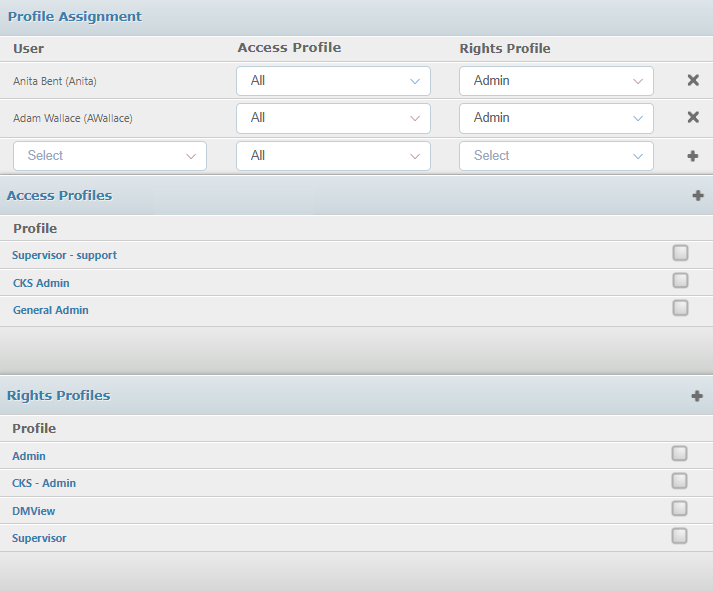
- On the Rights Profile panel, click the + button.
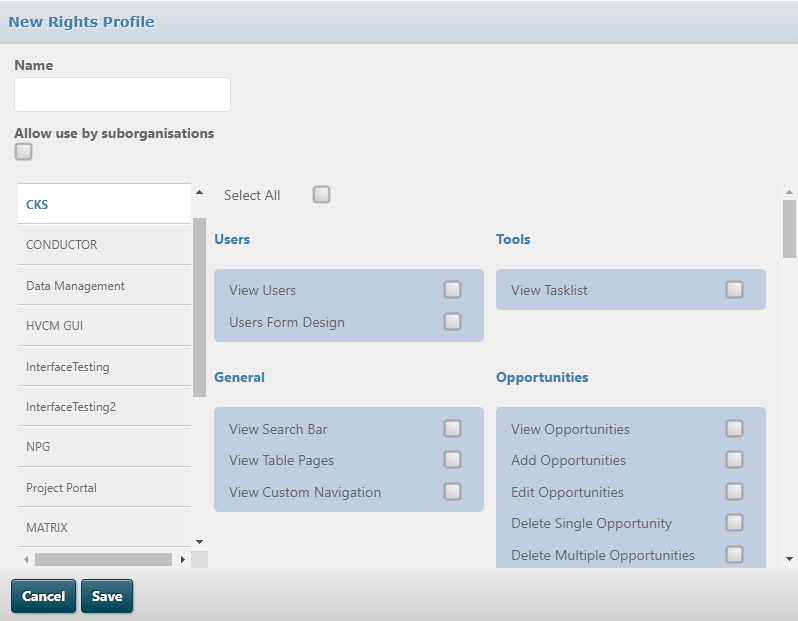
- Name the profile, select the storm product, then select the check box for each function that users to whom you will assign this profile are allowed to access. (Click Select All to select all the check boxes).
- Select the Allow use by sub-organisations check box if you wish to share the rights profile with sub-organisations.
- Click Save.
- On the Profile Assignment panel, which lists all users in your organisation, select the access profile in the Rights Profile column against each relevant user:

Notes: the selection against yourself must be set to ‘All’, otherwise the Access Profile options column will disappear immediately.
An access profile that restricts a recording manager from agent groups, agents, queues or treatments will affect the recordings that the user can see in storm RECORDER.
Hide storm Elements From Users Using Access Profiles
Note: if you are creating a CKS access profile, see also About CKS Access Profiles.
You create an access profile and then assign it to users:
- From the STUDIO main screen, select System Admin > User Profiles.

- The Profile Assignment window is opened.

- On the Access Profiles panel, click the + button.
- On the New Access Profile screen, name the rights profile, select the storm product on the left panel and then select the check box for each element that users to whom you assign this profile are allowed to access.
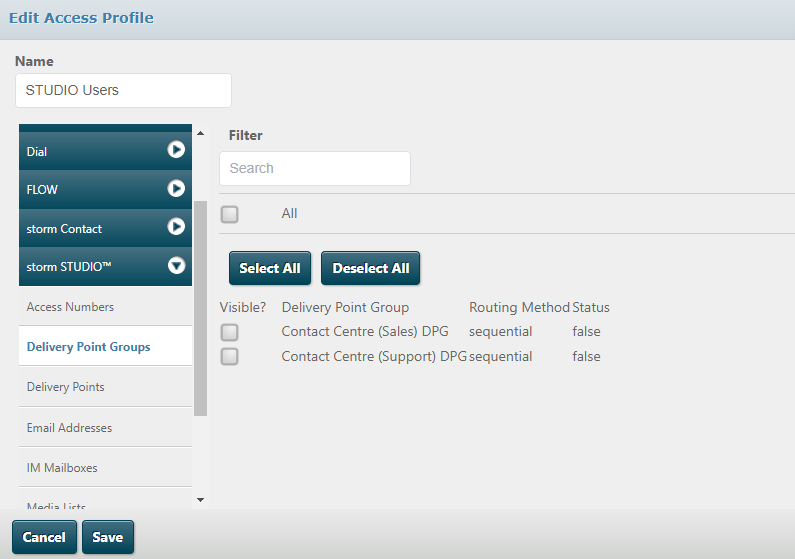
- Click Save.
- On the Profile Assignment panel, which lists all users in your organisation, select the access profile in the Access Profile column against each relevant user:

Filtering STUDIO Access Profiles
Access profiles can be filtered by user configured parameters. This allows you to use naming and/or extension conventions to edit multiple accesses profiles at once. This is especially useful for organisations with a large number of access profiles.
Note: this is only available for storm STUDIO access points.
- System Admin > User Profile.
- Scroll to Access Profiles.
- Click the relevant access profile.
- Select storm STUDIO.
- Select the relevant access profile.
The filter settings are displayed.
- Select an Operator.
Example: 'Starts With'.
- Select a Value.
Example: '07'.
- Click the + button to add more conditions to this Filter Set.
Lines can be deleted with the x button.
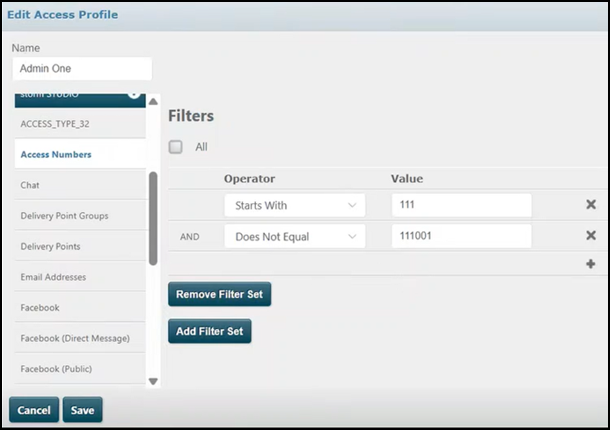
Note: additional filter sets can be added with the Add Filter Set button. This adds another conditional statement. Accesses points that fulfil either of these filter sets will be displayed.
- Click Save.
Any results that correspond with created filter sets will be displayed.
Example: you need to edit multiple access points that exclude numbers starting with 07 or ending in 123.
To achieve this in the filter settings:
The first Filter Set has an Operator assigned to 'Does Not Start With' and a Value set to '07'
A second Filter Set is added which has its Operator assigned to 'Does Not End With' and a Value set to '123'.
CKS Access Profiles
CKS access profiles can be used to restrict access to CKS records by record type and form, and by the content of specific fields.
- On the New Access Profile screen, select the CKS record type. In the following illustration, this is ‘Opportunities’.
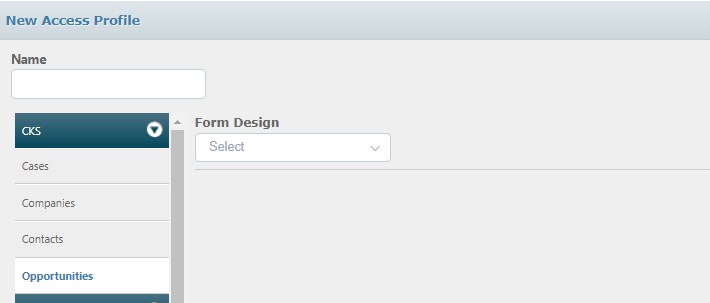
- Use the Form Design field to select the form. (If no forms have been set up for the selected CKS record type, the Form Design field displays the text string 'no data'). Once you select a form, additional fields are displayed.
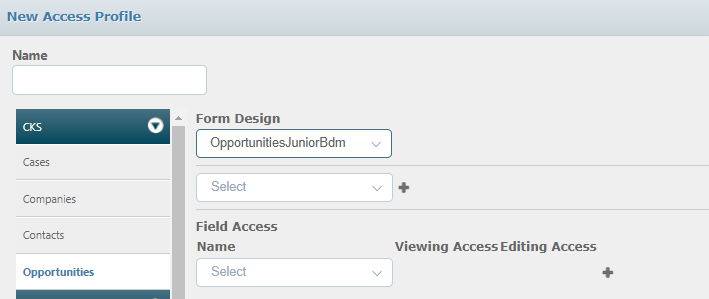
The fields under the Form Design heading are used to restrict access at field level by content. (That is, access is controlled by the value of the field, allowing you to restrict users to working with records for (for example) certain clients or regions).
The fields under the Field Access heading are used to set general field access. You can determine what they can see, and what amendments they can carry out, at individual field level. For viewing a field, the following options are available:
|
Option |
Description |
|
Default |
The user can see the field and its content. |
|
Not Visible (takes space in form) |
The user cannot see the content of the field, but a placeholder indicates that the field exists. |
|
Hidden (takes no space in form) |
The field, and its existence, is entirely hidden. |
For editing a field, the following options are available:
|
Option |
Description |
|
Default |
The user can see the field and can edit its content. |
|
Not Visible (takes space in form) |
The user cannot see the content of the field, but a placeholder indicates that the field exists. |
|
Hidden (takes no space in form) |
The field, and its existence, is entirely hidden. |
|
Read Only |
The user can see the field in read-only mode; they cannot amend its value. |
|
Read Only in Browser |
The user can see the field in read-only mode; they cannot amend its value in the browser, but can overwrite it using the file import mechanism. |
- To restrict access at field level, select the field using the Select drop-down list illustrated below.

- Click the + button next to the Select field. Two additional fields are displayed to allow you to set a filter on the selected field.

- Configure the filter by choosing an ‘equal’ (=) or ‘not equal’ (!=) comparator in the first field and then the desired value in the second field. For a check box that can be selected or left blank, type either ‘True’ (for selected) or ‘False’ (for blank). For a free-format field, type the exact value in full.
To limit access to records for a specific company, for example, set the fields as shown in the following illustration (where 'Bild Holdings' is the name of the company).

- Click the + button to save the filter settings.
- The Select field below the two filter fields allows you to select another field and repeat the above steps to set filters against it.
Note: you can set only one filter per field.
- To set general restrictions on field-level access, select the field using the Select drop-down list illustrated below.
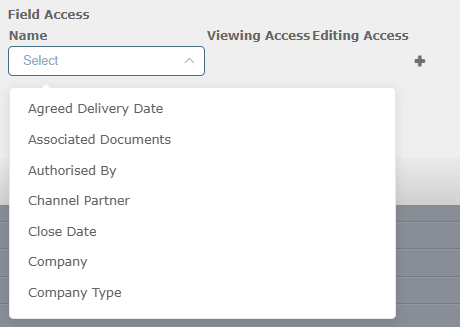
- Use the Viewing Access and Editing Access drop-downs to select the required setting for the field.

- Use the Select field that is displayed to repeat the process for the next field.
Note: the settings defined here override any filters configured on the same field.